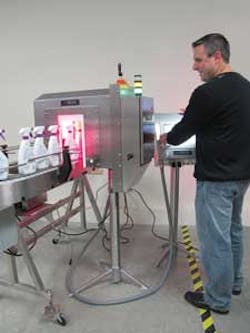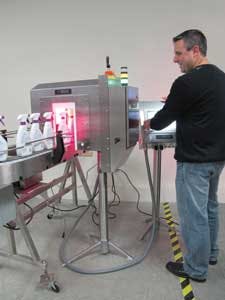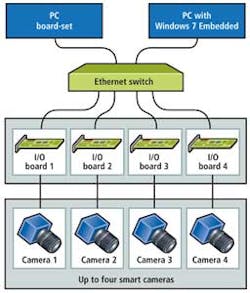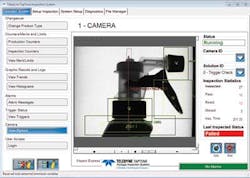INDUSTRIAL AUTOMATION PRODUCTS: Sensor-based System Taps into Packaging
Andrew Wilson, Editor
As a packaging inspection company, Teledyne TapTone has developed a number of automated systems using acoustic sensors, load cells, and x-ray technologies that can measure parameters such as fill levels, pressure and vacuum loss, leak detection, and package defects. With the acquisition of DALSA by TapTone's parent company, Teledyne Technologies, Teledyne TapTone has now embarked on developing a range of machine-vision products that extend the capabilities of the company's current packaging inspection systems.
"On most production lines," says Rob Chevalier, engineering manager at Teledyne TapTone, "customers require numerous inspection tasks to be performed on their products. These may include measuring whether a product is correctly labeled, whether components are present and in place, and whether a date, lot, or barcode is present and contains the correct information."
To address these requirements for the company's first vision-based package inspection systems, the TotalVu Sensor has been designed as a modular system to inspect bottles, cans, and containers (see Fig. 1).
The system's housing is mounted on a cantilevered arm that allows existing product lines to be retrofitted without the need for further system integration. Inside this housing, multiple brackets allow different types of camera and lighting components to be configured in a number of ways.
"Thus," says Chevalier, "direct or diffuse illumination in darkfield, brightfield, or rear illumination can be configured depending on the application to be performed." Similarly, because the system can support up to four Teledyne DALSA BOA smart cameras, it can be configured to simultaneously inspect products from a number of angles. By supporting TapTone's legacy acoustic, load cell, and x-ray sensors, the system can also make additional measurements as required.
Multiple sensors
To control and process data from these multiple sensors, TapTone has developed a proprietary board-set that consists of a separate I/O board, a Texas Instruments digital-signal-processor (DSP)-based processing board, and a communications board that are connected by a proprietary communications interface. The I/O board provides power and interfaces to the company's x-ray, load cell, and acoustic sensors, but it is also used to interface to photoelectric triggers and camera systems that may be required (see Fig. 2).
Data collected from these sensors are then transferred over the communications bus to the processor board where a TI DSP running a real-time operating system is used to process the data. Data from this board are then transferred to the communications board and transferred over an Ethernet interface to a color touch-screen from Pro-face.
While the processing board receives data from TapTone's legacy sensors, image-processing functions are performed directly in the CPU/DSP processor using the iNspect application software embedded in the BOA camera.
"By doing so," says Chevalier, "the TI DSP-based processor used to control the system is not burdened with any image-processing tasks." Images and the results of any image inspection tasks are then transferred through an Ethernet switch to both the proprietary system controller and to the color touch-screen interface. Pass/fail results from each camera can then be used by the proprietary DSP-based board-set to trigger pneumatic or mechanical actuators through the I/O interface.
Images can be simultaneously displayed on the monitor's color touch-screen interface and stored in real time on a separate PC running Windows 7, which is interfaced to the system through an Ethernet switch.
Spray containers
In an initial demonstration, Teledyne TapTone has shown how the system can be used to inspect household-chemical spray containers (see Fig. 3). A diffuse, flat, white LED light from Banner Engineering was mounted inside the TotalVu Sensor system. A single Teledyne DALSA BOA camera was then mounted on the opposite side of the system's housing so silhouette images of the containers would be captured by the camera as they move through the system.
As the containers pass along the conveyor belt, a photoelectric switch interfaced to the proprietary I/O controller board is used to trigger the camera.
Using the iNspect application software embedded in the BOA camera, regions of interest (ROIs) such as the nozzle, trigger, and cap are then highlighted in the captured image.
In the inspection demonstration, the system was required to inspect a number of different tasks. These included detecting the presence or absence of the cap and whether it was properly connected. Similarly, by measuring the height of the trigger and cap position, the system could determine whether they were properly threaded to the container body.
In-camera inspection
By using ROI tools to highlight the individual nozzle, trigger, and cap regions, caliper tools were set within the iNspect application software to determine pixel values within these ROIs. Measurement and verification tools within the iNspect software then checked for presence or correctness of features within these ROIs.
"Using these caliper-based tools, the system can be programmed to accept or reject parts based on different limits," says Chevalier. "In this way the number of false rejects and false accepts can be controlled."
Should the system detect an out-of-limit or defective measurement, the pass/fail result is transferred to the system's DSP-based controller board and an I/O signal sent to a downstream actuator to either remove the container from the conveyor or transfer it to another conveyor for recycling.
A second Windows-based PC in the system stores images of rejected parts for later retrieval and analysis. Analyzing these data then allows the end user to tailor the upstream manufacturing process as required.
Teledyne TapTone's first beta test customers will use the TotalVu Sensor for cap, label, and barcode recognition tasks. "In these systems," says Chevalier, "the number of cameras and the lighting configuration will need to be custom tailored to meet specific requirements." However, he adds, this will be easier because the system is configured in a modular fashion. Depending on the configurations of lighting, cameras, and external sensors, the cost of the system can range from $38,000–$60,000.
Company Info
Banner Engineering
Minneapolis, MN, USA
www.bannerengineering.com
Pro-face America
Ann Arbor, MI, USA
www.profaceamerica.com
Teledyne DALSA
Waterloo, ON, Canada
www.teledynedalsa.com
Teledyne TapTone
North Falmouth, MA, USA
www.taptone.com
Texas Instruments
Dallas, TX, USA
www.ti.com



